Consumer Behavior Essay: Involvement, Attitude Change, and Advertising
VerifiedAdded on 2023/03/23
|7
|1709
|97
Essay
AI Summary
This essay delves into the core concepts of consumer behavior, specifically examining the significance of involvement and attitude change within marketing strategies. It begins by tracing the evolution of consumer behavior as a distinct discipline, highlighting the shift from seller-centric to consumer-centric marketing approaches. The essay explores various factors influencing consumer behavior, including cultural, social, and personal elements, with a particular emphasis on the roles of attitude and beliefs in shaping purchasing decisions. The discussion then transitions to the construct of consumer involvement, differentiating between high and low involvement purchases and their impact on decision-making processes. The essay further analyzes the influence of social media on consumer behavior, emphasizing its role in brand awareness, customer engagement, and purchasing decisions. Finally, the essay outlines the objectives of advertising, including trial, continuity, brand switching, and switching back, and provides an example of an advertisement, analyzing how it can influence consumer behavior by increasing product visibility, brand awareness, and ultimately, sales.
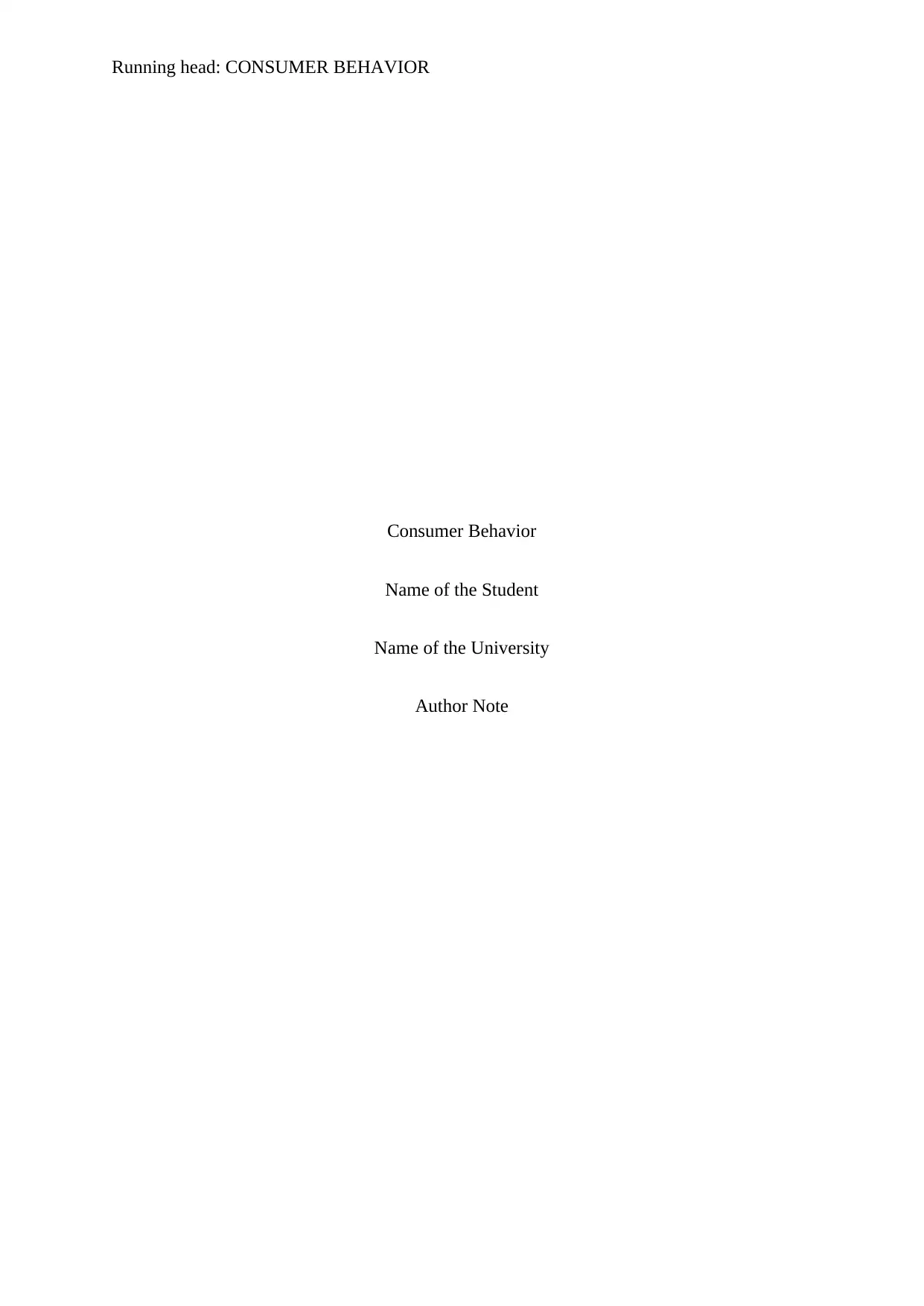
Running head: CONSUMER BEHAVIOR
Consumer Behavior
Name of the Student
Name of the University
Author Note
Consumer Behavior
Name of the Student
Name of the University
Author Note
Paraphrase This Document
Need a fresh take? Get an instant paraphrase of this document with our AI Paraphraser
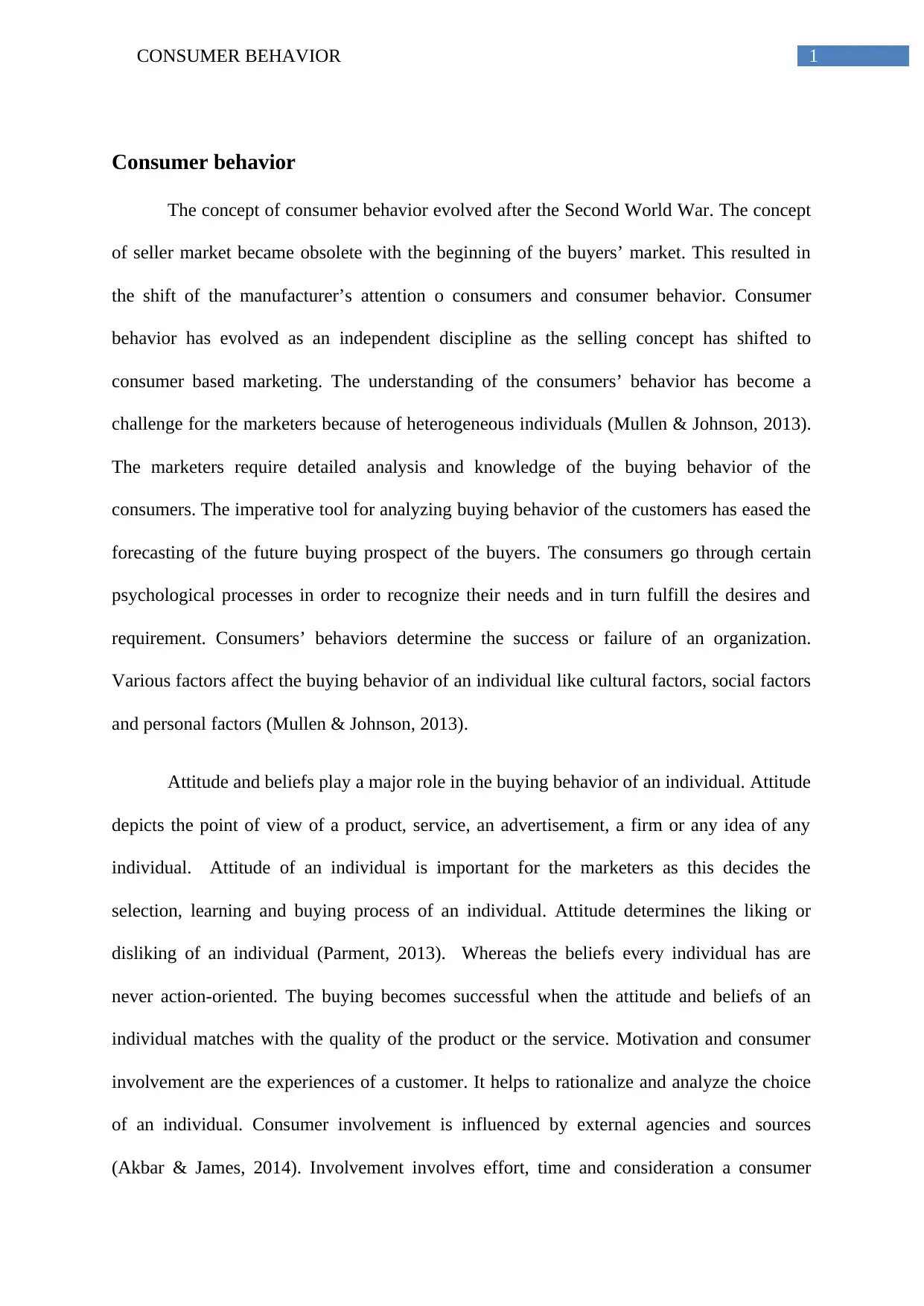
1CONSUMER BEHAVIOR
Consumer behavior
The concept of consumer behavior evolved after the Second World War. The concept
of seller market became obsolete with the beginning of the buyers’ market. This resulted in
the shift of the manufacturer’s attention o consumers and consumer behavior. Consumer
behavior has evolved as an independent discipline as the selling concept has shifted to
consumer based marketing. The understanding of the consumers’ behavior has become a
challenge for the marketers because of heterogeneous individuals (Mullen & Johnson, 2013).
The marketers require detailed analysis and knowledge of the buying behavior of the
consumers. The imperative tool for analyzing buying behavior of the customers has eased the
forecasting of the future buying prospect of the buyers. The consumers go through certain
psychological processes in order to recognize their needs and in turn fulfill the desires and
requirement. Consumers’ behaviors determine the success or failure of an organization.
Various factors affect the buying behavior of an individual like cultural factors, social factors
and personal factors (Mullen & Johnson, 2013).
Attitude and beliefs play a major role in the buying behavior of an individual. Attitude
depicts the point of view of a product, service, an advertisement, a firm or any idea of any
individual. Attitude of an individual is important for the marketers as this decides the
selection, learning and buying process of an individual. Attitude determines the liking or
disliking of an individual (Parment, 2013). Whereas the beliefs every individual has are
never action-oriented. The buying becomes successful when the attitude and beliefs of an
individual matches with the quality of the product or the service. Motivation and consumer
involvement are the experiences of a customer. It helps to rationalize and analyze the choice
of an individual. Consumer involvement is influenced by external agencies and sources
(Akbar & James, 2014). Involvement involves effort, time and consideration a consumer
Consumer behavior
The concept of consumer behavior evolved after the Second World War. The concept
of seller market became obsolete with the beginning of the buyers’ market. This resulted in
the shift of the manufacturer’s attention o consumers and consumer behavior. Consumer
behavior has evolved as an independent discipline as the selling concept has shifted to
consumer based marketing. The understanding of the consumers’ behavior has become a
challenge for the marketers because of heterogeneous individuals (Mullen & Johnson, 2013).
The marketers require detailed analysis and knowledge of the buying behavior of the
consumers. The imperative tool for analyzing buying behavior of the customers has eased the
forecasting of the future buying prospect of the buyers. The consumers go through certain
psychological processes in order to recognize their needs and in turn fulfill the desires and
requirement. Consumers’ behaviors determine the success or failure of an organization.
Various factors affect the buying behavior of an individual like cultural factors, social factors
and personal factors (Mullen & Johnson, 2013).
Attitude and beliefs play a major role in the buying behavior of an individual. Attitude
depicts the point of view of a product, service, an advertisement, a firm or any idea of any
individual. Attitude of an individual is important for the marketers as this decides the
selection, learning and buying process of an individual. Attitude determines the liking or
disliking of an individual (Parment, 2013). Whereas the beliefs every individual has are
never action-oriented. The buying becomes successful when the attitude and beliefs of an
individual matches with the quality of the product or the service. Motivation and consumer
involvement are the experiences of a customer. It helps to rationalize and analyze the choice
of an individual. Consumer involvement is influenced by external agencies and sources
(Akbar & James, 2014). Involvement involves effort, time and consideration a consumer
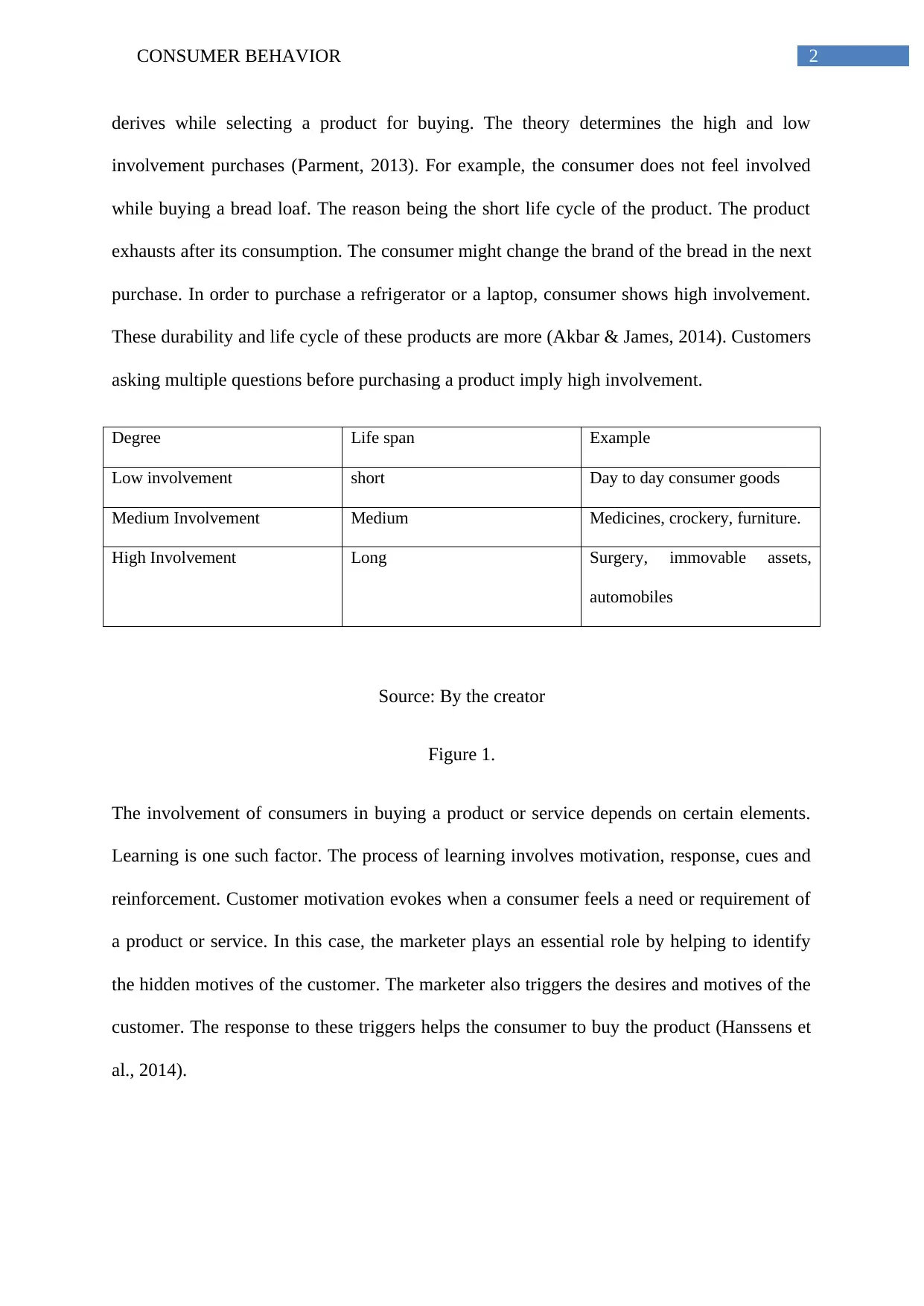
2CONSUMER BEHAVIOR
derives while selecting a product for buying. The theory determines the high and low
involvement purchases (Parment, 2013). For example, the consumer does not feel involved
while buying a bread loaf. The reason being the short life cycle of the product. The product
exhausts after its consumption. The consumer might change the brand of the bread in the next
purchase. In order to purchase a refrigerator or a laptop, consumer shows high involvement.
These durability and life cycle of these products are more (Akbar & James, 2014). Customers
asking multiple questions before purchasing a product imply high involvement.
Degree Life span Example
Low involvement short Day to day consumer goods
Medium Involvement Medium Medicines, crockery, furniture.
High Involvement Long Surgery, immovable assets,
automobiles
Source: By the creator
Figure 1.
The involvement of consumers in buying a product or service depends on certain elements.
Learning is one such factor. The process of learning involves motivation, response, cues and
reinforcement. Customer motivation evokes when a consumer feels a need or requirement of
a product or service. In this case, the marketer plays an essential role by helping to identify
the hidden motives of the customer. The marketer also triggers the desires and motives of the
customer. The response to these triggers helps the consumer to buy the product (Hanssens et
al., 2014).
derives while selecting a product for buying. The theory determines the high and low
involvement purchases (Parment, 2013). For example, the consumer does not feel involved
while buying a bread loaf. The reason being the short life cycle of the product. The product
exhausts after its consumption. The consumer might change the brand of the bread in the next
purchase. In order to purchase a refrigerator or a laptop, consumer shows high involvement.
These durability and life cycle of these products are more (Akbar & James, 2014). Customers
asking multiple questions before purchasing a product imply high involvement.
Degree Life span Example
Low involvement short Day to day consumer goods
Medium Involvement Medium Medicines, crockery, furniture.
High Involvement Long Surgery, immovable assets,
automobiles
Source: By the creator
Figure 1.
The involvement of consumers in buying a product or service depends on certain elements.
Learning is one such factor. The process of learning involves motivation, response, cues and
reinforcement. Customer motivation evokes when a consumer feels a need or requirement of
a product or service. In this case, the marketer plays an essential role by helping to identify
the hidden motives of the customer. The marketer also triggers the desires and motives of the
customer. The response to these triggers helps the consumer to buy the product (Hanssens et
al., 2014).
⊘ This is a preview!⊘
Do you want full access?
Subscribe today to unlock all pages.

Trusted by 1+ million students worldwide
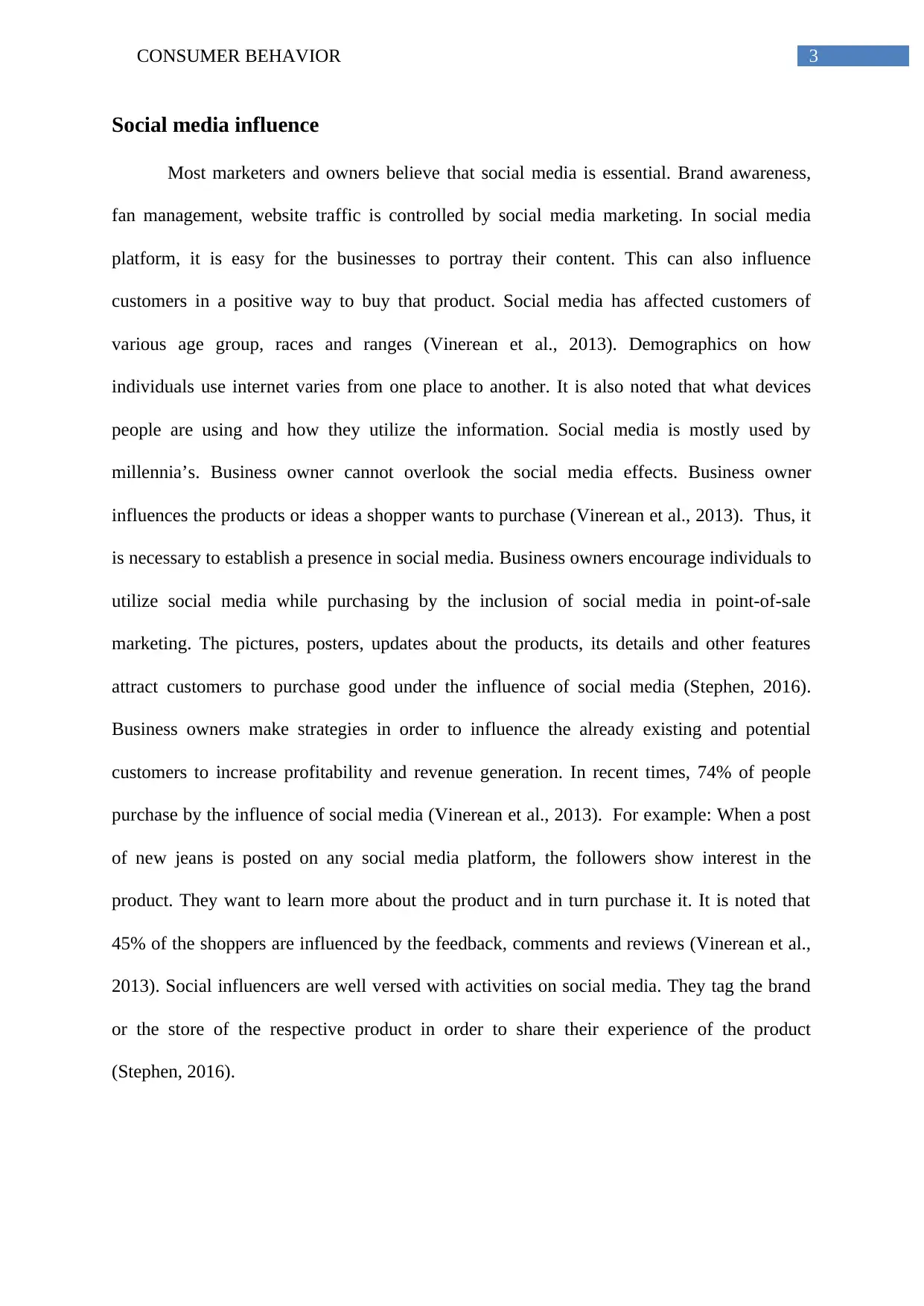
3CONSUMER BEHAVIOR
Social media influence
Most marketers and owners believe that social media is essential. Brand awareness,
fan management, website traffic is controlled by social media marketing. In social media
platform, it is easy for the businesses to portray their content. This can also influence
customers in a positive way to buy that product. Social media has affected customers of
various age group, races and ranges (Vinerean et al., 2013). Demographics on how
individuals use internet varies from one place to another. It is also noted that what devices
people are using and how they utilize the information. Social media is mostly used by
millennia’s. Business owner cannot overlook the social media effects. Business owner
influences the products or ideas a shopper wants to purchase (Vinerean et al., 2013). Thus, it
is necessary to establish a presence in social media. Business owners encourage individuals to
utilize social media while purchasing by the inclusion of social media in point-of-sale
marketing. The pictures, posters, updates about the products, its details and other features
attract customers to purchase good under the influence of social media (Stephen, 2016).
Business owners make strategies in order to influence the already existing and potential
customers to increase profitability and revenue generation. In recent times, 74% of people
purchase by the influence of social media (Vinerean et al., 2013). For example: When a post
of new jeans is posted on any social media platform, the followers show interest in the
product. They want to learn more about the product and in turn purchase it. It is noted that
45% of the shoppers are influenced by the feedback, comments and reviews (Vinerean et al.,
2013). Social influencers are well versed with activities on social media. They tag the brand
or the store of the respective product in order to share their experience of the product
(Stephen, 2016).
Social media influence
Most marketers and owners believe that social media is essential. Brand awareness,
fan management, website traffic is controlled by social media marketing. In social media
platform, it is easy for the businesses to portray their content. This can also influence
customers in a positive way to buy that product. Social media has affected customers of
various age group, races and ranges (Vinerean et al., 2013). Demographics on how
individuals use internet varies from one place to another. It is also noted that what devices
people are using and how they utilize the information. Social media is mostly used by
millennia’s. Business owner cannot overlook the social media effects. Business owner
influences the products or ideas a shopper wants to purchase (Vinerean et al., 2013). Thus, it
is necessary to establish a presence in social media. Business owners encourage individuals to
utilize social media while purchasing by the inclusion of social media in point-of-sale
marketing. The pictures, posters, updates about the products, its details and other features
attract customers to purchase good under the influence of social media (Stephen, 2016).
Business owners make strategies in order to influence the already existing and potential
customers to increase profitability and revenue generation. In recent times, 74% of people
purchase by the influence of social media (Vinerean et al., 2013). For example: When a post
of new jeans is posted on any social media platform, the followers show interest in the
product. They want to learn more about the product and in turn purchase it. It is noted that
45% of the shoppers are influenced by the feedback, comments and reviews (Vinerean et al.,
2013). Social influencers are well versed with activities on social media. They tag the brand
or the store of the respective product in order to share their experience of the product
(Stephen, 2016).
Paraphrase This Document
Need a fresh take? Get an instant paraphrase of this document with our AI Paraphraser
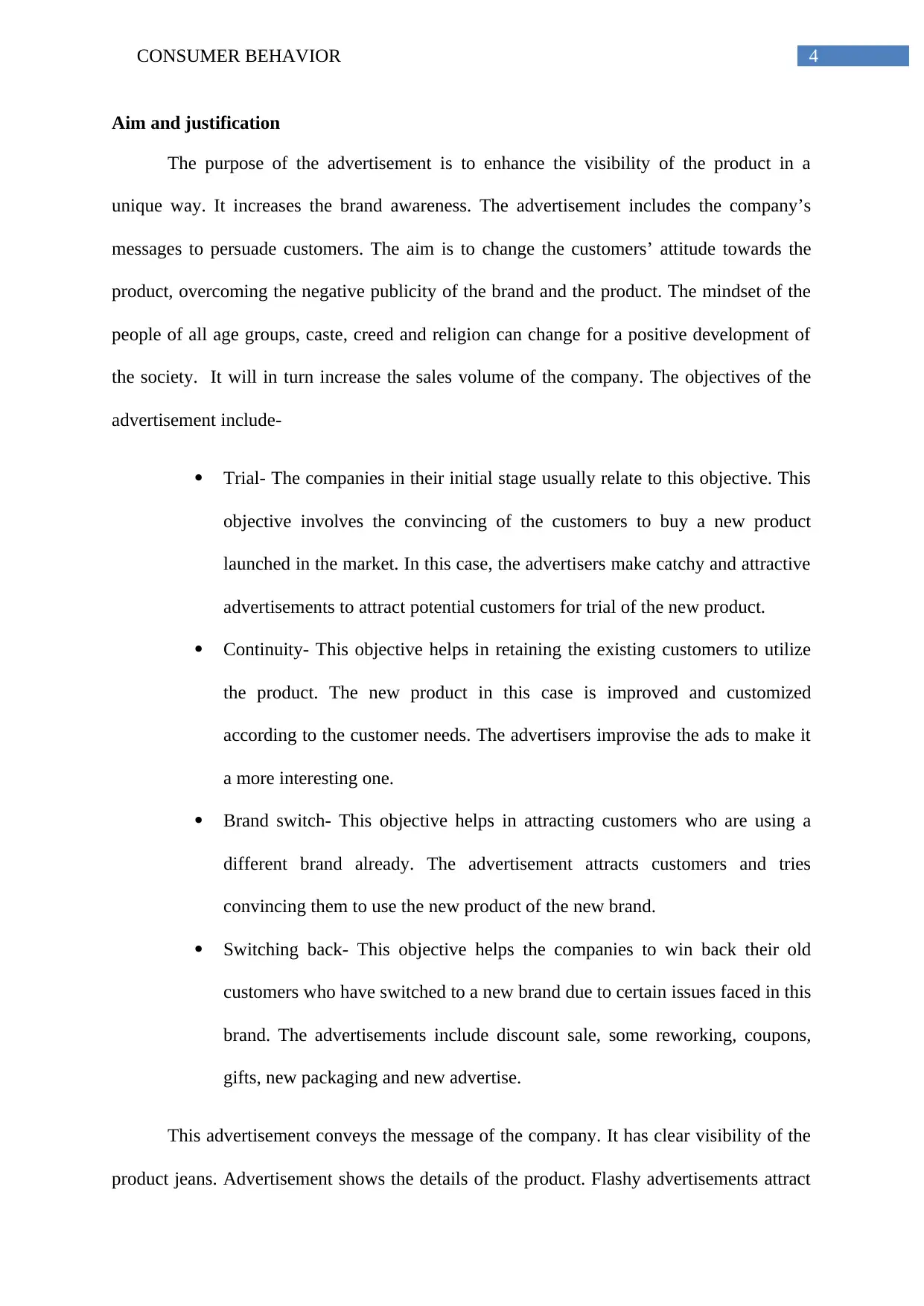
4CONSUMER BEHAVIOR
Aim and justification
The purpose of the advertisement is to enhance the visibility of the product in a
unique way. It increases the brand awareness. The advertisement includes the company’s
messages to persuade customers. The aim is to change the customers’ attitude towards the
product, overcoming the negative publicity of the brand and the product. The mindset of the
people of all age groups, caste, creed and religion can change for a positive development of
the society. It will in turn increase the sales volume of the company. The objectives of the
advertisement include-
Trial- The companies in their initial stage usually relate to this objective. This
objective involves the convincing of the customers to buy a new product
launched in the market. In this case, the advertisers make catchy and attractive
advertisements to attract potential customers for trial of the new product.
Continuity- This objective helps in retaining the existing customers to utilize
the product. The new product in this case is improved and customized
according to the customer needs. The advertisers improvise the ads to make it
a more interesting one.
Brand switch- This objective helps in attracting customers who are using a
different brand already. The advertisement attracts customers and tries
convincing them to use the new product of the new brand.
Switching back- This objective helps the companies to win back their old
customers who have switched to a new brand due to certain issues faced in this
brand. The advertisements include discount sale, some reworking, coupons,
gifts, new packaging and new advertise.
This advertisement conveys the message of the company. It has clear visibility of the
product jeans. Advertisement shows the details of the product. Flashy advertisements attract
Aim and justification
The purpose of the advertisement is to enhance the visibility of the product in a
unique way. It increases the brand awareness. The advertisement includes the company’s
messages to persuade customers. The aim is to change the customers’ attitude towards the
product, overcoming the negative publicity of the brand and the product. The mindset of the
people of all age groups, caste, creed and religion can change for a positive development of
the society. It will in turn increase the sales volume of the company. The objectives of the
advertisement include-
Trial- The companies in their initial stage usually relate to this objective. This
objective involves the convincing of the customers to buy a new product
launched in the market. In this case, the advertisers make catchy and attractive
advertisements to attract potential customers for trial of the new product.
Continuity- This objective helps in retaining the existing customers to utilize
the product. The new product in this case is improved and customized
according to the customer needs. The advertisers improvise the ads to make it
a more interesting one.
Brand switch- This objective helps in attracting customers who are using a
different brand already. The advertisement attracts customers and tries
convincing them to use the new product of the new brand.
Switching back- This objective helps the companies to win back their old
customers who have switched to a new brand due to certain issues faced in this
brand. The advertisements include discount sale, some reworking, coupons,
gifts, new packaging and new advertise.
This advertisement conveys the message of the company. It has clear visibility of the
product jeans. Advertisement shows the details of the product. Flashy advertisements attract
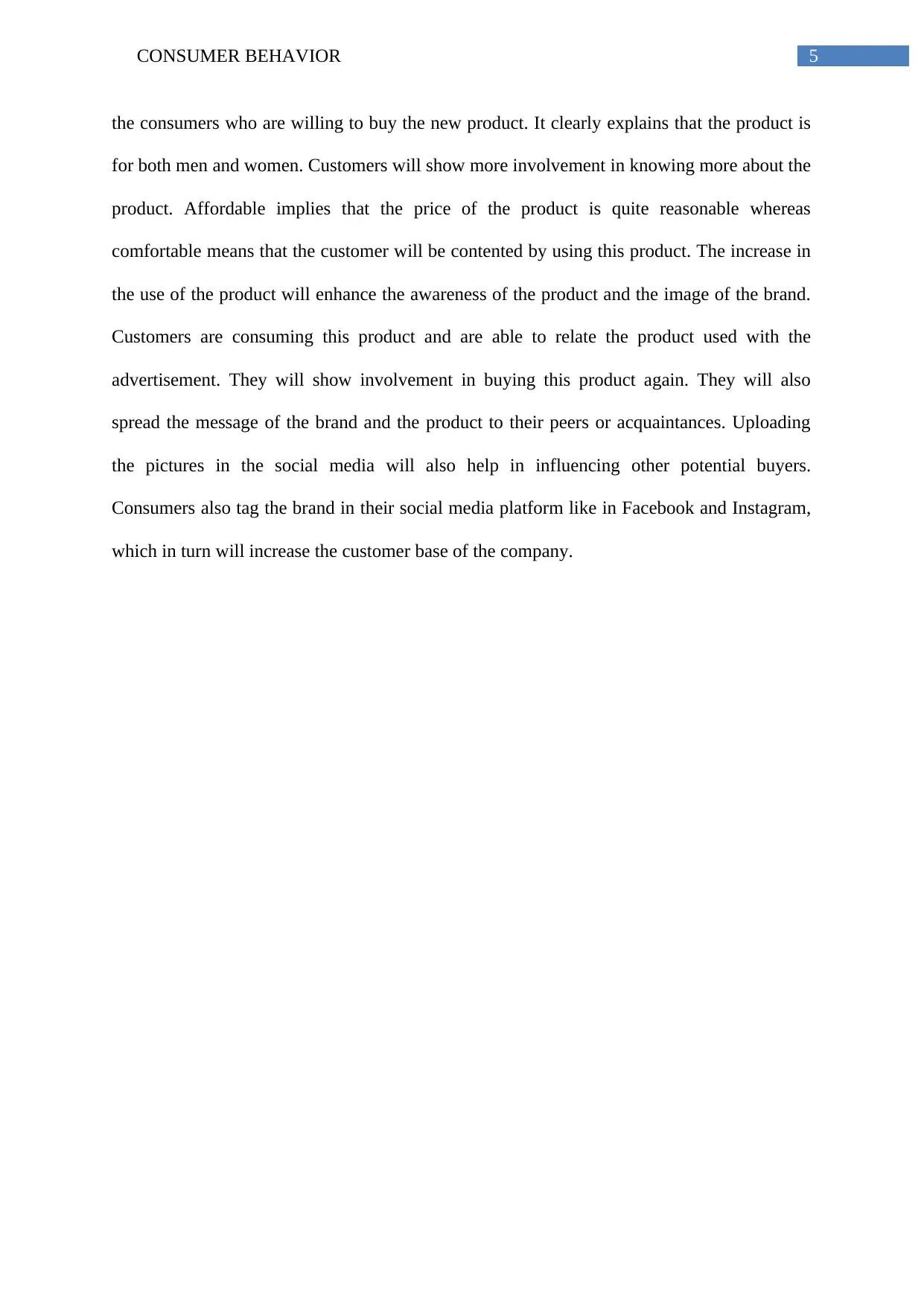
5CONSUMER BEHAVIOR
the consumers who are willing to buy the new product. It clearly explains that the product is
for both men and women. Customers will show more involvement in knowing more about the
product. Affordable implies that the price of the product is quite reasonable whereas
comfortable means that the customer will be contented by using this product. The increase in
the use of the product will enhance the awareness of the product and the image of the brand.
Customers are consuming this product and are able to relate the product used with the
advertisement. They will show involvement in buying this product again. They will also
spread the message of the brand and the product to their peers or acquaintances. Uploading
the pictures in the social media will also help in influencing other potential buyers.
Consumers also tag the brand in their social media platform like in Facebook and Instagram,
which in turn will increase the customer base of the company.
the consumers who are willing to buy the new product. It clearly explains that the product is
for both men and women. Customers will show more involvement in knowing more about the
product. Affordable implies that the price of the product is quite reasonable whereas
comfortable means that the customer will be contented by using this product. The increase in
the use of the product will enhance the awareness of the product and the image of the brand.
Customers are consuming this product and are able to relate the product used with the
advertisement. They will show involvement in buying this product again. They will also
spread the message of the brand and the product to their peers or acquaintances. Uploading
the pictures in the social media will also help in influencing other potential buyers.
Consumers also tag the brand in their social media platform like in Facebook and Instagram,
which in turn will increase the customer base of the company.
⊘ This is a preview!⊘
Do you want full access?
Subscribe today to unlock all pages.

Trusted by 1+ million students worldwide
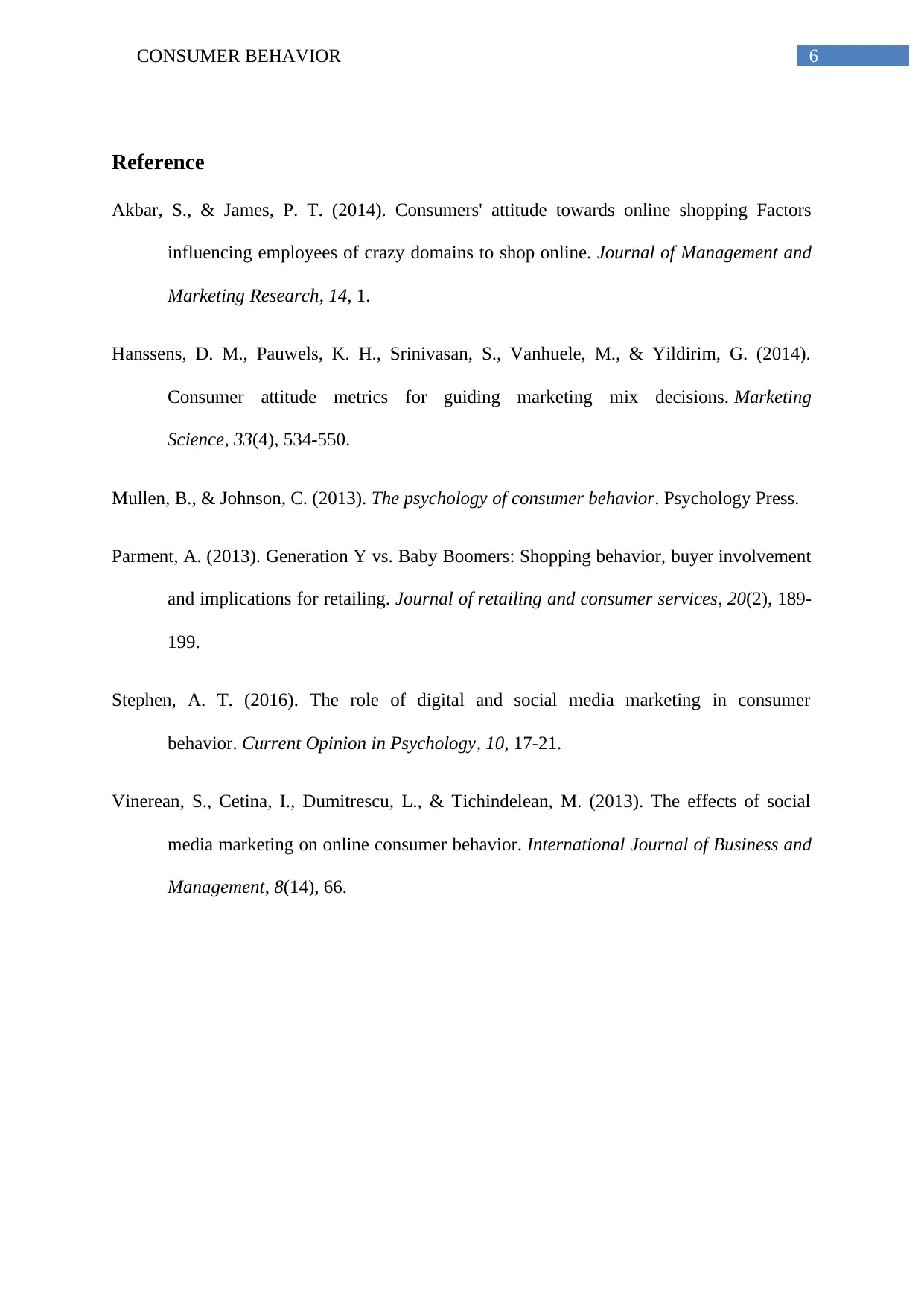
6CONSUMER BEHAVIOR
Reference
Akbar, S., & James, P. T. (2014). Consumers' attitude towards online shopping Factors
influencing employees of crazy domains to shop online. Journal of Management and
Marketing Research, 14, 1.
Hanssens, D. M., Pauwels, K. H., Srinivasan, S., Vanhuele, M., & Yildirim, G. (2014).
Consumer attitude metrics for guiding marketing mix decisions. Marketing
Science, 33(4), 534-550.
Mullen, B., & Johnson, C. (2013). The psychology of consumer behavior. Psychology Press.
Parment, A. (2013). Generation Y vs. Baby Boomers: Shopping behavior, buyer involvement
and implications for retailing. Journal of retailing and consumer services, 20(2), 189-
199.
Stephen, A. T. (2016). The role of digital and social media marketing in consumer
behavior. Current Opinion in Psychology, 10, 17-21.
Vinerean, S., Cetina, I., Dumitrescu, L., & Tichindelean, M. (2013). The effects of social
media marketing on online consumer behavior. International Journal of Business and
Management, 8(14), 66.
Reference
Akbar, S., & James, P. T. (2014). Consumers' attitude towards online shopping Factors
influencing employees of crazy domains to shop online. Journal of Management and
Marketing Research, 14, 1.
Hanssens, D. M., Pauwels, K. H., Srinivasan, S., Vanhuele, M., & Yildirim, G. (2014).
Consumer attitude metrics for guiding marketing mix decisions. Marketing
Science, 33(4), 534-550.
Mullen, B., & Johnson, C. (2013). The psychology of consumer behavior. Psychology Press.
Parment, A. (2013). Generation Y vs. Baby Boomers: Shopping behavior, buyer involvement
and implications for retailing. Journal of retailing and consumer services, 20(2), 189-
199.
Stephen, A. T. (2016). The role of digital and social media marketing in consumer
behavior. Current Opinion in Psychology, 10, 17-21.
Vinerean, S., Cetina, I., Dumitrescu, L., & Tichindelean, M. (2013). The effects of social
media marketing on online consumer behavior. International Journal of Business and
Management, 8(14), 66.
1 out of 7
Related Documents
Your All-in-One AI-Powered Toolkit for Academic Success.
+13062052269
info@desklib.com
Available 24*7 on WhatsApp / Email
![[object Object]](/_next/static/media/star-bottom.7253800d.svg)
Unlock your academic potential
Copyright © 2020–2025 A2Z Services. All Rights Reserved. Developed and managed by ZUCOL.




